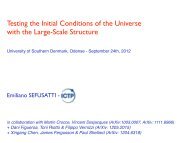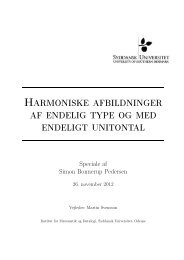A high-resolution version for printing - CP3-Origins
A high-resolution version for printing - CP3-Origins
A high-resolution version for printing - CP3-Origins
Create successful ePaper yourself
Turn your PDF publications into a flip-book with our unique Google optimized e-Paper software.
CP violation is also relevant <strong>for</strong> cosmology: it is one of the three conditions of Sakharov necessary<br />
<strong>for</strong> a dynamical explanation of the observed baryon asymmetry of the universe (together<br />
with baryon number violation and deviation from thermal equilibrium). The amount of CP violation<br />
provided by the SM is, however, too tiny to explain the baryon asymmetry observed in<br />
the universe: there must be at least one additional source of CP violation beyond the SM, yet to<br />
be discovered by laboratory experiments.<br />
CP violating phenomena beyond the SM that could be detected by ongoing and planned laboratory<br />
experiments include: deviations from the SM description of the quark mixings, to be<br />
probed mainly by the LHCb experiment at CERN; neutrino oscillations, because future long<br />
baseline experiments could detect the CP violating PMNS-phase; fermion Electric Dipole Moments.<br />
The origin of CP violation is poorly understood and is intimately linked to various open problems<br />
in particle physics: the violation of flavour, the number of fermion generations, the nature<br />
of the Higgs field and its role in the spontaneous breaking of the electroweak symmetry. In general,<br />
theories beyond the SM possess many sources of CP violation. This is <strong>for</strong> instance the case<br />
in supersymmetric models.<br />
We plan to:<br />
• Study and characterise new sources of CP violation associated to: observable deviations from<br />
the CKM-description of the quark mixings; non-unitary neutrino oscillations; observable fermion<br />
EDMs.<br />
• From the model building point of view, we plan to analyse in particular: models with TeVscale<br />
neutrinos, like the one we have put <strong>for</strong>ward (See the Natural Fourth Family subsection),<br />
which can be probed at LHC; models with minimal flavour violation and/or models with<br />
flavour symmetries.<br />
• Explore mechanisms to solve the CP and flavour problems of low-energy theories beyond the<br />
SM. In this respect we will consider various frameworks beyond the SM: extended Higgs sectors<br />
or alternative electroweak symmetry breaking models, grand unification, supersymmetry,<br />
extra-dimensions, etc.<br />
• Investigate mechanisms <strong>for</strong> the generation of the baryon asymmetry of the universe, and to<br />
consider related astroparticle issues. For instance, we plan to explore the leptogenesis scenario.<br />
These investigations will involve many cosmological aspects which we will address: phase transitions,<br />
inflation, dark matter, dark energy, etc.<br />
CP³-Black book 15








